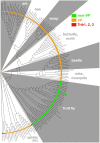Control of Cell Growth and Proliferation by the Tribbles Pseudokinase: Lessons from Drosophila
- PMID: 33672471
- PMCID: PMC7923445
- DOI: 10.3390/cancers13040883
Control of Cell Growth and Proliferation by the Tribbles Pseudokinase: Lessons from Drosophila
Abstract
The Tribbles (Trib) family of pseudokinase proteins regulate cell growth, proliferation, and differentiation during normal development and in response to environmental stress. Mutations in human Trib isoforms (Trib1, 2, and 3) have been associated with metabolic disease and linked to leukemia and the formation of solid tumors, including melanomas, hepatomas, and lung cancers. Drosophila Tribbles (Trbl) was the first identified member of this sub-family of pseudokinases and shares a conserved structure and similar functions to bind and direct the degradation of key mediators of cell growth and proliferation. Common Trib targets include Akt kinase (also known as protein kinase B), C/EBP (CAAT/enhancer binding protein) transcription factors, and Cdc25 phosphatases, leading to the notion that Trib family members stand athwart multiple pathways modulating their growth-promoting activities. Recent work using the Drosophila model has provided important insights into novel facets of conserved Tribbles functions in stem cell quiescence, tissue regeneration, metabolism connected to insulin signaling, and tumor formation linked to the Hippo signaling pathway. Here we highlight some of these recent studies and discuss their implications for understanding the complex roles Tribs play in cancers and disease pathologies.
Keywords: Trib protein family; cancer; growth; pseudokinase.
Conflict of interest statement
The authors declare no conflict of interest.
Figures



References
Publication types
Grants and funding
LinkOut - more resources
Full Text Sources
Other Literature Sources
Molecular Biology Databases
Research Materials

